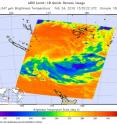NASA sees strong vertical wind shear battering a weaker winston
Tropical Cyclone Winston has moved into an area with strong vertical wind shear in the Southern Pacific Ocean. The wind shear is battering the storm and has weakened it significantly. NASA's Aqua satellite passed over Winston and infrared data showed that the northerly wind shear had pushed the bulk of strongest storms to the south of the center. The Joint Typhoon Warning Center upper-level analysis showed Winston had moved into an unfavorable environment with strong (30 to 40 knots/34.5 to 46 mph/55.5 to 74 kph) vertical wind shear.
At 1500 UTC (10 a.m. EST) on Feb. 24, 2016 Tropical cyclone Winston had weakened to a tropical storm. Maximum sustained winds were near 45 knots (51.7 mph/83.3 kph). It was centered near 24.5 degrees south latitude and 173.9 degrees east longitude, about 459 nautical miles (528.2 miles/850.1 km) south-southwest of Suva, Fiji. Winston was moving to the west at 9 knots (10.3 mph/16.6 kph).
The Atmospheric Infrared Sounder or AIRS instrument that flies aboard NASA's Aqua satellite measured temperatures in Tropical Storm Winston's cloud tops on Feb. 24, 2016 at 11:47 UTC (6:47 a.m. EST). AIRS saw a few strong storms remaining in the system, but they were pushed to the south because of strong vertical wind shear. Thunderstorms in that quadrant had coldest cloud tops near minus 63 degrees Fahrenheit (minus 53 degrees Celsius). Cloud tops around the rest of the tropical storm were much warmer indicating they were lower in the atmosphere and less potent storms.
Winston is forecast to move to the south-southwest and stay far to the south of New Caledonia. As it moves, it is expected to weaken and become sub-tropical south of New Caledonia within the next day.
Source: NASA/Goddard Space Flight Center
Articles on the same topic
- NASA's Terra satellite sees Tropical Cyclone Yalo coming to a quick endFri, 26 Feb 2016, 17:33:58 UTC
- NASA's Aqua satellite catches the birth of Tropical Cyclone YaloThu, 25 Feb 2016, 19:38:56 UTC
- NASA sees Winston winding down near Norfolk IslandThu, 25 Feb 2016, 19:38:38 UTC
- NASA sees pinhole eye seen in weakening Tropical Cyclone WinstonWed, 24 Feb 2016, 18:12:55 UTC
- NASA sees category 5 southern Pacific Tropical cyclone hit FijiMon, 22 Feb 2016, 19:22:30 UTC
- NASA sees major Tropical Cyclone Winston approaching FijiFri, 19 Feb 2016, 22:53:32 UTC
- NASA infrared imagery shows wind shear affecting Tropical Cyclone UriahFri, 19 Feb 2016, 22:53:23 UTC
- NASA sees Tropical Cyclone Winston U-turn toward FijiFri, 19 Feb 2016, 22:53:14 UTC
- NASA catches Tropical Cyclone Uriah nearing peakFri, 19 Feb 2016, 22:52:53 UTC
- NASA sees Tropical Cyclone Winston intensifying near TongaFri, 19 Feb 2016, 22:52:43 UTC
Other sources
- NASA's Terra satellite sees Tropical Cyclone Yalo coming to a quick endfrom PhysorgFri, 26 Feb 2016, 18:01:39 UTC
- Aqua satellite catches the birth of Tropical Cyclone Yalofrom PhysorgThu, 25 Feb 2016, 19:30:38 UTC
- NASA sees Winston winding down near Norfolk Islandfrom PhysorgThu, 25 Feb 2016, 19:30:37 UTC
- NASA sees strong vertical wind shear battering a weaker winstonfrom PhysorgWed, 24 Feb 2016, 19:00:33 UTC
- NASA sees pinhole eye seen in weakening Tropical Cyclone Winstonfrom PhysorgTue, 23 Feb 2016, 18:30:39 UTC
- Monster Cyclone Winston Seen from Space (Photos)from Space.comTue, 23 Feb 2016, 14:50:27 UTC
- NASA sees category 5 southern Pacific Tropical cyclone hit Fijifrom PhysorgMon, 22 Feb 2016, 19:20:31 UTC
- Death toll in Fiji jumps to 20 as Cyclone Winston cleanup beginsfrom UPIMon, 22 Feb 2016, 14:30:36 UTC
- Death toll from Fiji cyclone hits 18 as aid sent to islandsfrom PhysorgMon, 22 Feb 2016, 9:30:32 UTC
- Major cyclone kills at least 10 in Fiji, destroys hundreds of homesfrom UPISun, 21 Feb 2016, 17:00:35 UTC
- Death toll from ferocious Fiji cyclone rises to 3from PhysorgSun, 21 Feb 2016, 9:30:38 UTC
- Powerful cyclone batters Fiji islands, maintains strengthfrom UPISat, 20 Feb 2016, 20:00:29 UTC
- Ferocious cyclone strikes Pacific island nation of Fijifrom PhysorgSat, 20 Feb 2016, 14:40:24 UTC
- Fiji hunkers down as formidable cyclone nears main islandsfrom PhysorgSat, 20 Feb 2016, 9:50:34 UTC
- Fiji hunkers down as formidable cyclone nears main islandsfrom AP ScienceSat, 20 Feb 2016, 4:00:28 UTC
- NASA sees major Tropical Cyclone Winston approaching Fijifrom PhysorgFri, 19 Feb 2016, 22:50:33 UTC
- NASA sees Tropical Cyclone Winston U-turn toward Fijifrom PhysorgThu, 18 Feb 2016, 21:01:03 UTC
- NASA catches Tropical Cyclone Uriah nearing peakfrom PhysorgWed, 17 Feb 2016, 19:42:51 UTC
- NASA sees Tropical Cyclone Winston intensifying near Tongafrom PhysorgWed, 17 Feb 2016, 19:42:49 UTC
